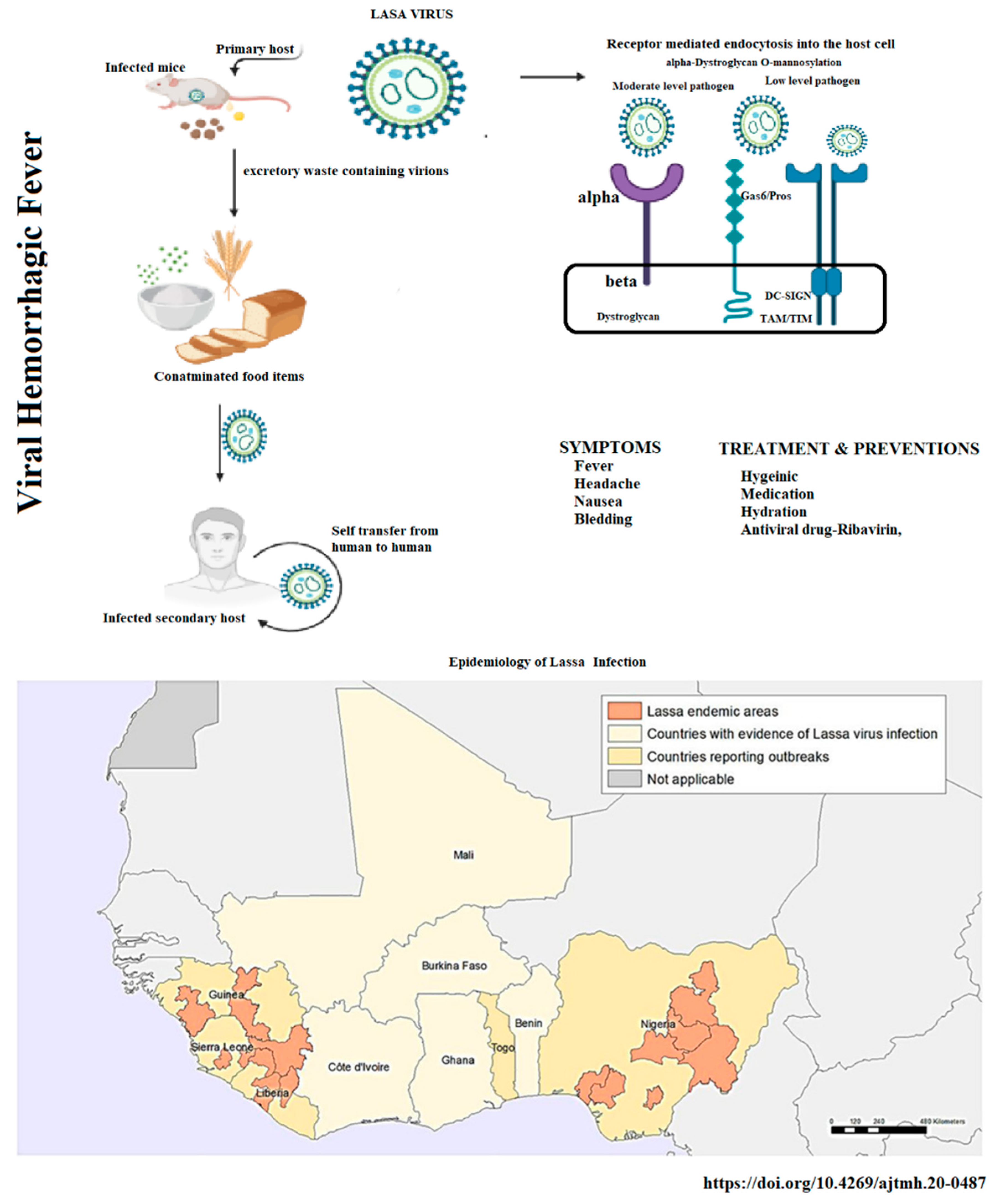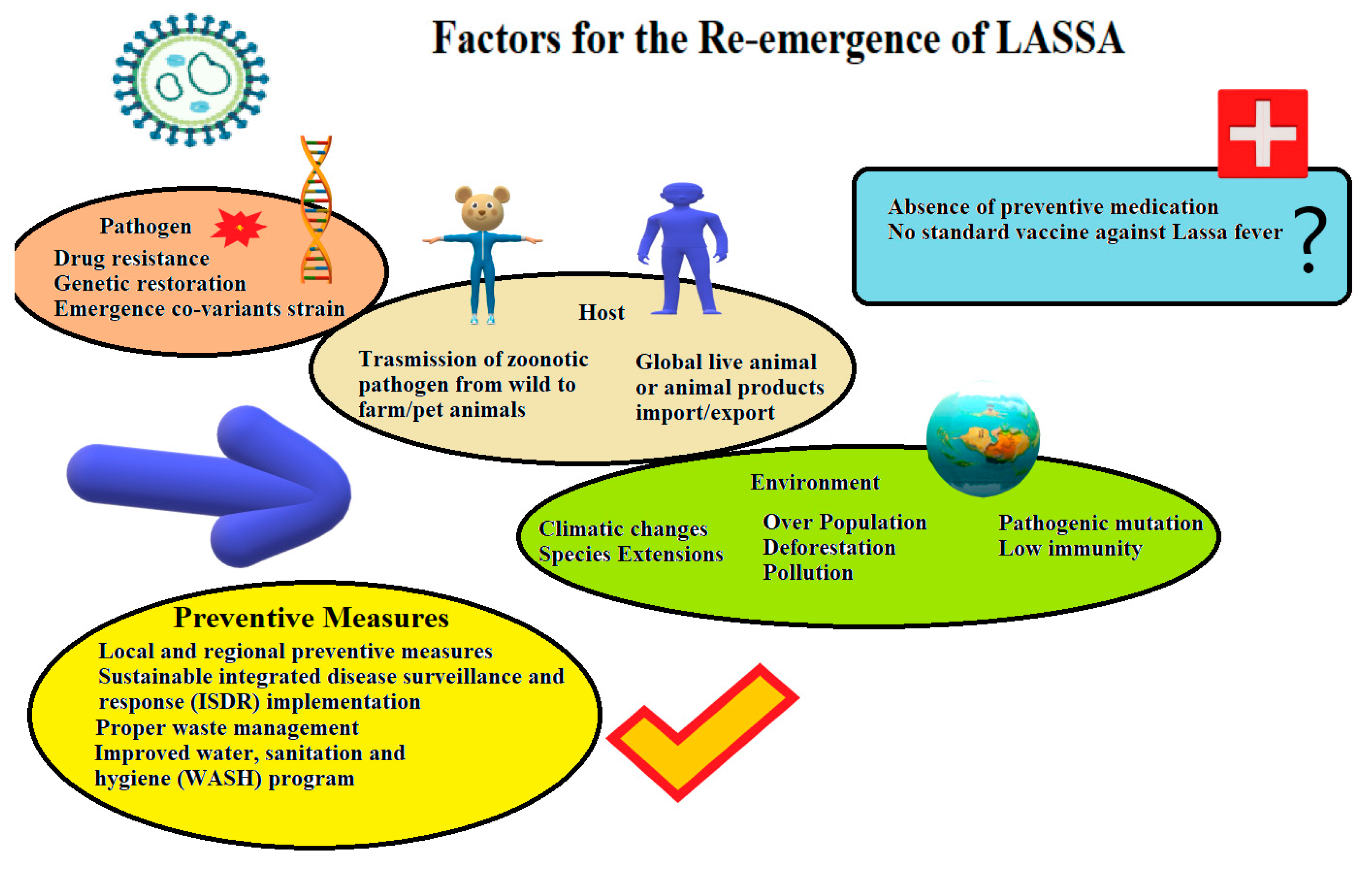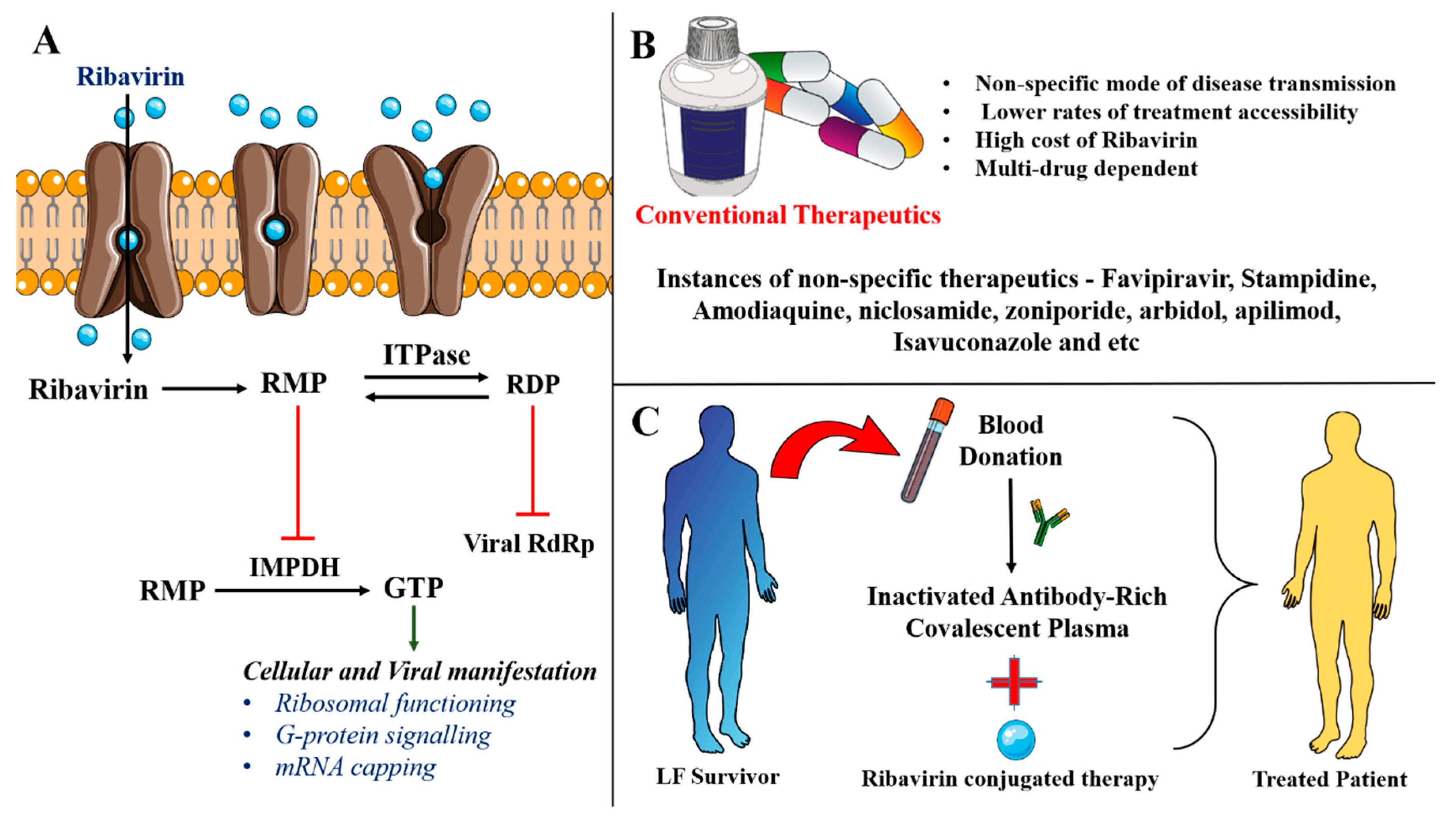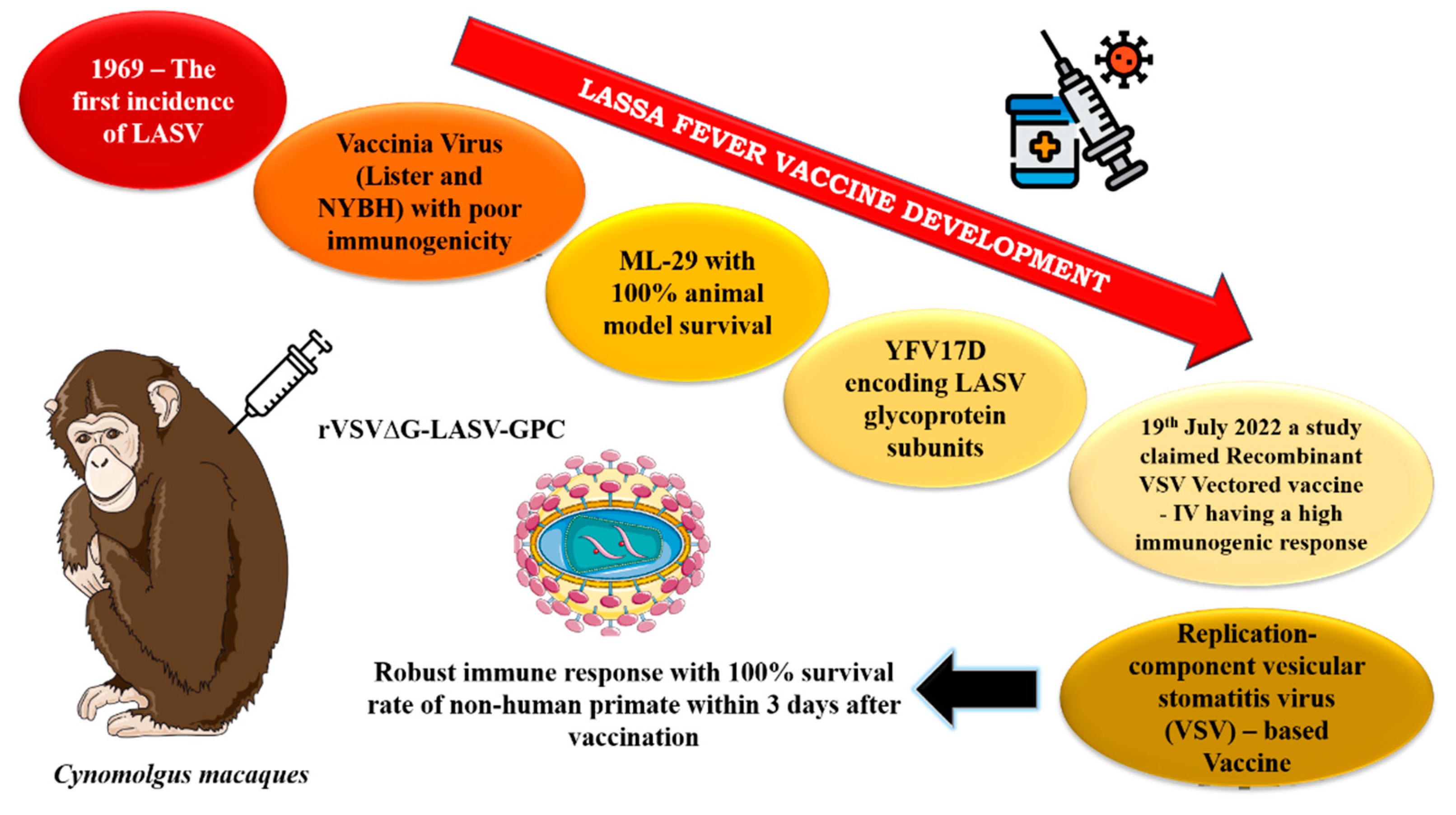Submitted:
11 April 2023
Posted:
12 April 2023
You are already at the latest version
Abstract
Keywords:
1. Introduction
2. Mode of transmission of Lassa virus
3. Pathogenesis and virulence factors
4. Clinical Features
5. Phases or outbreaks of Lassa Fever Outbreaks in Nigeria
| Year | No. of patients (approx.) |
No. of deaths (approx.) |
n (%) of deaths | References |
|---|---|---|---|---|
| 2001 | 6150 | 16 | 0.3 | [70] |
| 2002 | 8850 | 23 | 0.3 | |
| 2003 | 9092 | 22 | 0.2 | |
| 2004 | 8388 | 25 | 0.3 | |
| 2005 | 9215 | 65 | 0.7 | |
| 2006 | 11060 | 54 | 0.5 | |
| 2007 | 11644 | 56 | 0.5 | |
| 2008 | 13617 | 38 | 0.3 | |
| 2009 | 12292 | 56 | 0.5 | |
| 2010 | 12374 | 76 | 0.6 | |
| 2011 | 11537 | 62 | 0.5 | |
| 2012 | 13589 | 113 | 0.8 | |
| 2013 | 10969 | 83 | 0.8 | |
| 2014 | 8671 | 67 | 0.8 | |
| 2015 | 10793 | 31 | 0.3 | |
| 2016 | 9566 | 102 | 1.1 | |
| 2017 | 11537 | 161 | 1.4 | |
| 2018 | 7363 | 248 | 3.4 | |
| 2019 | 8392 | 154 | 1.8 | [71] |
| 2020 | 7390 | 244 | 3.1 | [72] |
| 2021 | 4214 | 80 | 1.8 | [73] |
| 2022 (42nd week) | 8268 | 177 | 2.1 | [74] |
6. Factors Contributing to re-emergence of Lassa Fever epidemics
6.1. Nosocomial transmission
6.2. Travel and Migration
6.3. Public health systems
6.4. Climate and Environment
6.5. Social factors
6.6. Effects of Civil War and Conflicts
6.7. COVID-19 Pandemic influence
7. Preventive measures (pre-clinical, clinical trials, Measures and vaccines, medication, and vaccines)
| Vaccine/Drug | Clinical trial ID | Function | References |
|---|---|---|---|
| Ribavirin | NCT04285034 | Cardiovascular function and pharmacokinetics and pharmacodynamics of ribavirin in Lassa fever. | [75] |
| INO-4500 | NCT04093076 | Safety, tolerability, and immunogenicity of the drug in healthy volunteers of Ghana. | [75] |
| rVSV∆G-LASV-GPC | NCT04794218 | Evaluation of the Safety and Immunogenicity of rVSV∆G-LASV-GPC vaccine in adults in good health conditions. | [76] |
| MV-LASV (V182-001) | NCT04055454 | We are investigating the safety, tolerability, and immunogenicity of two doses of MV-LASV. | [77] |
| LHF-535 | NCT03993704 | It assesses the safety, tolerability, and pharmacokinetics of a daily oral dose of LHF-535 administered to healthy individuals. | [52] |
8. Conclusions & future perspectives
References
- Radoshitzky, S. R. , Bào, Y., Buchmeier, M. J., Charrel, R. N., Clawson, A. N., Clegg, C. S., DeRisi, J. L., Emonet, S., Gonzalez, J. P., Kuhn, J. H., Lukashevich, I. S., Peters, C. J., Romanowski, V., Salvato, M. S., Stenglein, M. D., & de la Torre, J. C. (2015). Past, present, and future of arenavirus taxonomy. Archives of Virology, 160(7), 1851–1874. [CrossRef]
- Andersen, K. G., Shapiro, B. J., Matranga, C. B., Sea(LHF) on, R., Lin, A. E., Moses, L. M., Folarin, O. A., Goba, A., Odia, I., Ehiane, P. E., Momoh, M., England, E. M., Winnicki, S., Branco, L. M., Gire, S. K., Phelan, E., Tariyal, R., Tewhey, R., Omoniwa, O., Fullah, M., … Sabeti, P. C. (2015). Clinical Sequencing Uncovers Origins and Evolution of Lassa Virus. Cell, 162(4), 738–750. [CrossRef]
- Whitmer, S. L. M. , Strecker, T., Cadar, D., Dienes, H. P., Faber, K., Patel, K., Brown, S. M., Davis, W. G., Klena, J. D., Rollin, P. E., Schmidt-Chanasit, J., Fichet-Calvet, E., Noack, B., Emmerich, P., Rieger, T., Wo(LHF) f, S., Fehling, S. K., Eickmann, M., Mengel, J. P., Schultze, T., … Günther, S. (2018). New Lineage of Lassa Virus, Togo, 2016. Emerging infectious diseases, 24(3), 599–602. [CrossRef]
- Kafetzopoulou, L. E., Pullan, S. T., Lemey, P., Suchard, M. A., Ehichioya, D. U., Pahlmann, M., Thielebein, A., Hinzmann, J., Oestereich, L., Wozniak, D. M., Efthymiadis, K., Schachten, D., Koenig, F., Matjeschk, J., Lorenzen, S., Lumley, S., Ighodalo, Y., Adomeh, D. I., Olokor, T., Omomoh, E., … Duraffour, S. (2019). Metagenomic sequencing at the epicenter of the Nigeria 2018 Lassa fever outbreak. Science (New York, N.Y.), 363(6422), 74–77. [CrossRef]
- Lukashevich I., S. (2013). The search for animal models for Lassa fever vaccine development. Expert review of vaccines, 12(1), 71–86. [CrossRef]
- Hallam, H.J. , Hallam, S., Rodriguez, S.E. et al. Baseline mapping of Lassa fever virology, epidemiology and vaccine research and development. npj Vaccines 3, 11 (2018). [CrossRef]
- Siddle, K. J., Eromon, P., Barnes, K. G., Mehta, S., Oguzie, J. U., Odia, I., Schaffner, S. F., Winnicki, S. M., Shah, R. R., Qu, J., Wohl, S., Brehio, P., Iruolagbe, C., Aiyepada, J., Uyigue, E., Akhilomen, P., Okonofua, G., Ye, S., Kayode, T., Ajogbasile, F., … Happi, C. T. (2018). Genomic Analysis of Lassa Virus during an Increase in Cases in Nigeria in 2018. The New England journal of medicine, 379(18), 1745–1753. [CrossRef]
- Akpede, G. O. , Asogun, D. A., Okogbenin, S. A., & Okokhere, P. O. (2018). Lassa fever outbreaks in Nigeria. Expert review of anti-infective therapy, 16(9), 663–666. [CrossRef]
- Gibb, R., Moses, L. M., Redding, D. W., & Jones, K. E. (2017). Understanding the cryptic nature of Lassa fever in West Africa. Pathogens and global health, 111(6), 276–288. [CrossRef]
- Yun, N. E., & Walker, D. H. (2012). Pathogenesis of Lassa fever. Viruses, 4(10), 2031–2048. [CrossRef]
- Safronetz, D. , Sogoba, N., Lopez, J. E., Maiga, O., Dahlstrom, E., Zivcec, M., Feldmann, F., Haddock, E., Fischer, R. J., Anderson, J. M., Munster, V. J., Branco, L., Garry, R., Porcella, S. F., Schwan, T. G., & Feldmann, H. (2013, December 5). Geographic Distribution and Genetic Characterization of Lassa Virus in Sub-Saharan Mali. PLoS Neglected Tropical Diseases, 7(12), e2582. [CrossRef]
- Sogoba, N. , Feldmann, H., & Safronetz, D. (2012, September). Lassa Fever in West Africa: Evidence for an Expanded Region of Endemicity. Zoonoses and Public Health, 59, 43–47. [CrossRef]
- Adebayo, D. , & Amaechi Nwobi, E. (2015). Response Preparedness to Viral Hemorrhagic Fever in Nigeria: Risk Perception, Attitude towards Lassa Fever. Epidemiology: Open Access, 05(03). [CrossRef]
- Nikisins, S., Rieger, T., Patel, P., Müller, R., Günther, S., & Niedrig, M. (2015). International external quality assessment study for molecular detection of Lassa virus. PLoS neglected tropical diseases, 9(5), e0003793. [CrossRef]
- Lecompte, E., Fichet-Calvet, E., Daffis, S., Koulémou, K., Sylla, O., Kourouma, F., Doré, A., Soropogui, B., Aniskin, V., Allali, B., Kouassi Kan, S., Lalis, A., Koivogui, L., Günther, S., Denys, C., & ter Meulen, J. (2006). Mastomys natalensis and Lassa fever, West Africa. Emerging infectious diseases, 12(12), 1971–1974. (. [CrossRef]
- Olayemi, A., Obadare, A., Oyeyiola, A., Igbokwe, J., Fasogbon, A., Igbahenah, F., Ortsega, D., Asogun, D., Umeh, P., Vakkai, I., Abejegah, C., Pahlman, M., Becker-Ziaja, B., Günther, S., & Fichet-Calvet, E. (2016). Arenavirus Diversity and Phylogeography of Mastomys natalensis Rodents, Nigeria. Emerging infectious diseases, 22(4), 694–697. (. [CrossRef]
- Coulibaly-N'Golo, D. , Allali, B., Kouassi, S. K., Fichet-Calvet, E., Becker-Ziaja, B., Rieger, T., Olschläger, S., Dosso, H., Denys, C., Ter Meulen, J., Akoua-Koffi, C., & Günther, S. (2011). Novel arenavirus sequences in Hylomyscus sp. and Mus (Nannomys) setulosus from Côte d'Ivoire: implications for evolution of arenaviruses in Africa. PloS one, 6(6), e20893. [CrossRef]
- WHO 2019. Lassa fever. Available at: https://www.who.int/emergencies/diseases/lassa-fever/en/. Accessed March 18, 2019.
- CDC. Transmission: Lassa fever. 2014. Available at: https://www.cdc.gov. Accessed March 17, 2019.
- Bonwitt, J., Kandeh, M., Dawson, M., Ansumana, R., Sahr, F., Kelly, A. H., & Brown, H. (2017). Participation of women and children in hunting activities in Sierra Leone and implications for control of zoonotic infections. PLoS neglected tropical diseases, 11(7), e0005699. [CrossRef]
- Bonwitt, J. , Kelly, A. H., Ansumana, R., Agbla, S., Sahr, F., Saez, A. M., Borchert, M., Kock, R., & Fichet-Calvet, E. (2016). Rat-atouille: A Mixed Method Study to Characterize Rodent Hunting and Consumption in the Context of Lassa Fever. EcoHealth, 13(2), 234–247. [CrossRef]
- Bonwitt, J. , Sáez, A. M., Lamin, J., Ansumana, R., Dawson, M., Buanie, J., Lamin, J., Sondufu, D., Borchert, M., Sahr, F., Fichet-Calvet, E., & Brown, H. (2017). At Home with Mastomys and Rattus: Human-Rodent Interactions and Potential for Primary Transmission of Lassa Virus in Domestic Spaces. The American journal of tropical medicine and hygiene, 96(4), 935–943. [CrossRef]
- Akhuemokhan, O. C., Ewah-Odiase, R. O., Akpede, N., Ehimuan, J., Adomeh, D. I., Odia, I., Olomu, S. C., Pahlmann, M., Becker-Ziaja, B., Happi, C. T., Asogun, D. A., Okogbenin, S. A., Okokhere, P. O., Dawodu, O. S., Omoike, I. U., Sabeti, P. C., Günther, S., & Akpede, G. O. (2017). Prevalence of Lassa Virus Disease (LVD) in Nigerian children with fever or fever and convulsions in an endemic area. PLoS neglected tropical diseases, 11(7), e0005711. [CrossRef]
- Bello, O. O. , Akinajo, O. R., Odubamowo, K. H., & Oluwasola, T. A. (2016). Lassa Fever in Pregnancy: Report of 2 Cases Seen at the University College Hospital, Ibadan. Case reports in obstetrics and gynecology, 2016, 9673683. [CrossRef]
- Dan-Nwafor, C. C. , Ipadeola, O., Smout, E., Ilori, E., Adeyemo, A., Umeokonkwo, C., Nwidi, D., Nwachukwu, W., Ukponu, W., Omabe, E., Anaebonam, U., Igwenyi, N., Igbodo, G., Eteng, W., Uzoma, I., Saleh, M., Agboeze, J., Mutbam, S., de Gooyer, T., Short, R., … Ihekweazu, C. (2019). A cluster of nosocomial Lassa fever cases in a tertiary health facility in Nigeria: Description and lessons learned, 2018. International journal of infectious diseases : IJID : official publication of the International Society for Infectious Diseases, 83, 88–94. [CrossRef]
- Brosh-Nissimov, T. (2016). Lassa fever: another threat from West Africa. Disaster and military medicine, 2, 8. [CrossRef]
- Xing, J. , Ly, H., & Liang, Y. (2015). The Z proteins of pathogenic but not nonpathogenic arenaviruses inhibit RIG-I-like receptor-dependent interferon production. Journal of virology, 89(5), 2944–2955. [CrossRef]
- Paessler, S., & Walker, D. H. (2013). Pathogenesis of the viral hemorrhagic fevers. Annual review of pathology, 8, 411–440. [CrossRef]
- Zinzula, L. , & Tramontano, E. (2013). Strategies of highly pathogenic RNA viruses to block dsRNA detection by RIG-I-like receptors: hide, mask, hit. Antiviral research, 100(3), 615–635. [CrossRef]
- Watanabe, Y., Raghwani, J., Allen, J. D., Seabright, G. E., Li, S., Moser, F., Huiskonen, J. T., Strecker, T., Bowden, T. A., & Crispin, M. (2018). Structure of the Lassa virus glycan shield provides a model for immunological resistance. Proceedings of the National Academy of Sciences of the United States of America, 115(28), 7320–7325. [CrossRef]
- Raabe, V. , Mehta, A. K., Evans, J. D., & Science Working Group of the National Emerging Special Pathogens Training and Education Center (NETEC) Special Pathogens Research Network (SPRN) (2022). Lassa Virus Infection: a Summary for Clinicians. International journal of infectious diseases : IJID : official publication of the International Society for Infectious Diseases, 119, 187–200. [CrossRef]
- Forni, D. , Pontremoli, C., Pozzoli, U., Clerici, M., Cagliani, R., & Sironi, M. (2018). Ancient Evolution of Mammarenaviruses: Adaptation via Changes in the L Protein and No Evidence for Host-Virus Codivergence. Genome biology and evolution, 10(3), 863–874. [CrossRef]
- World Health Organization. WHO R&D blueprint.“Efficacy trials of Lassa therapeutics: endpoints, trial design, site selection” WHO workshop—final report. 2018. Apr 25 [cited 2022 Mar 22].
- McCormick, J. B., & Fisher-Hoch, S. P. (2002). Lassa fever. Current topics in microbiology and immunology, 262, 75–109. [CrossRef]
- Asogun, D. A. , Günther, S., Akpede, G. O., Ihekweazu, C., & Zumla, A. (2019). Lassa fever: epidemiology, clinical features, diagnosis, management and prevention. Infectious Disease Clinics, 33(4), 933-951. [CrossRef]
- Garry, R. F. (2022). Lassa fever—the road ahead. Nature Reviews Microbiology, 1-10.
- Peterson, A. T. , Moses, L. M., & Bausch, D. G. (2014). Mapping transmission risk of Lassa fever in West Africa: the importance of quality control, sampling bias, and error weighting. PLoS One, 9(8), e100711. [CrossRef]
- Shehu, N. Y. , Gomerep, S. S., Isa, S. E., Iraoyah, K. O., Mafuka, J., Bitrus, N.,... & Paessler, S. (2018). Lassa fever 2016 outbreak in Plateau State, Nigeria—The changing epidemiology and clinical presentation. Frontiers in public health, 6, 232. [CrossRef]
- Monath, T. P. (2019). A short history of Lassa fever: The first 10–15 years after discovery. Current Opinion in Virology, 37, 77-83. [CrossRef]
- Ölschläger, S. , Lelke, M., Emmerich, P., Panning, M., Drosten, C., Hass, M.,... & Günther, S. (2010). Improved detection of Lassa virus by reverse transcription-PCR targeting the 5′ region of S RNA. Journal of clinical microbiology, 48(6), 2009-2013. [CrossRef]
- Isa, S. E., Shehu, N. Y., Juryit, R. N., Simji, S. G., Shuaibu, J. A., Egah, D. Z., ... & Chikaike, O. (2013). Epidemiological and clinical description of Lassa fever in Jos, Nigeria. Highland Medical Research Journal, 13(1), 3-7.
- Kernéis, S. , Koivogui, L., Magassouba, N. F., Koulemou, K., Lewis, R., Aplogan, A.,... & Fichet-Calvet, E. (2009). Prevalence and risk factors of Lassa seropositivity in inhabitants of the forest region of Guinea: a cross-sectional study. PLoS Neglected Tropical Diseases, 3(11), e548. [CrossRef]
- Gayer, M., Legros, D., Formenty, P., & Connolly, M. A. (2007). Conflict and emerging infectious diseases. Emerging infectious diseases, 13(11), 1625. [CrossRef]
- Richmond, J. K. , & Baglole, D. J. (2003). Lassa fever: epidemiology, clinical features, and social consequences. Bmj, 327(7426), 1271-1275. [CrossRef]
- Balogun, O. O. , Akande, O. W., & Hamer, D. H. (2021). Lassa Fever: An Evolving Emergency in West Africa. The American Journal of Tropical Medicine and Hygiene, 104(2), 466. [CrossRef]
- Massawe, A. W., Makundi, R. H., Zhang, Z., Mhamphi, G., Liu, M., Li, H. J., & Belmain, S. R. (2018). Effect of synthetic hormones on reproduction in Mastomys natalensis. Journal of Pest Science, 91(1), 157-168. [CrossRef]
- Abdullahi, I. N., Anka, A. U., Ghamba, P. E., Onukegbe, N. B., Amadu, D. O., & Salami, M. O. (2020). Need for preventive and control measures for Lassa fever through the one health strategic approach. Proceedings of Singapore Healthcare, 29(3), 190-194. [CrossRef]
- Gibb, R., Moses, L. M., Redding, D. W., & Jones, K. E. (2017). Understanding the cryptic nature of Lassa fever in West Africa. Pathogens and global health, 111(6), 276-288. [CrossRef]
- Shaffer, J. G. , Grant, D. S., Schieffelin, J. S., Boisen, M. L., Goba, A., Hartnett, J. N., Levy, D. C., Yenni, R. E., Moses, L. M., Fullah, M., Momoh, M., Fonnie, M., Fonnie, R., Kanneh, L., Koroma, V. J., Kargbo, K., Ottomassathien, D., Muncy, I. J., Jones, A. B.,... Garry, R. F. (2014, March 20). Lassa Fever in Post-Conflict Sierra Leone. PLoS Neglected Tropical Diseases, 8(3), e2748. [CrossRef]
- Lalis, A., Leblois, R., Lecompte, E., Denys, C., ter Meulen, J., & Wirth, T. (2012, May 15). The Impact of Human Conflict on the Genetics of Mastomys natalensis and Lassa Virus in West Africa. PLoS ONE, 7(5), e37068. [CrossRef]
- Versteeg, G. A. , & García-Sastre, A. (2010, August). Viral tricks to grid-lock the type I interferon system. Current Opinion in Microbiology, 13(4), 508–516. [CrossRef]
- Diamond, M.S. , Kanneganti, TD. Innate immunity: the first line of defense against SARS-CoV-2. Nat Immunol 23, 165–176 (2022). [CrossRef]
- Happi, A. N. , Happi, C. T., & Schoepp, R. J. (2019). Lassa fever diagnostics: Past, present, and future. Current Opinion in Virology, 37, 132–138. [CrossRef]
- Gowen, B. B., & Bray, M. (2011). Progress in the experimental therapy of severe arenaviral infections. Future Microbiology, 6(12), 1429–1441. 6, 12, 1429–1441. [CrossRef]
- Alli, A. , Ortiz, J. F., Fabara, S. P., Patel, A., & Halan, T. (2021). Management of Lassa Fever: A Current Update. Cureus, 13(5), e14797. [CrossRef]
- Zhang, X. , Tang, K., & Guo, Y. (2020). The antifungal isavuconazole inhibits the entry of lassa virus by targeting the stable signal peptide-GP2 subunit interface of Lassa virus glycoprotein. Antiviral Research, 174, 104701. [CrossRef]
- Hulseberg, C. , Fénéant, L., Szymańska-de Wijs, K., Kessler, N., Nelson, E., Shoemaker, C., Schmaljohn, C., Polyak, S., & White, J. (2019). Arbidol and other low-molecular-weight drugs that inhibit Lassa and Ebola viruses. Journal of Virology, 93(8), e02185-18. [CrossRef]
- Ölschläger, S., Neyts, J., & Günther, S. (2011). Depletion of GTP pool is not the predominant mechanism by which ribavirin exerts its antiviral effect on Lassa virus. Antiviral Research, 91(2), 89–93. [CrossRef]
- Wang, P. , Liu, Y., Zhang, G., Wang, S., Guo, J., Cao, J., Jia, X., Zhang, L., Xiao, G., & Wang, W. (2018). Screening and Identification of Lassa Virus Entry Inhibitors from an FDA-Approved Drug Library. Journal of Virology, 92(16), e00954-18. [CrossRef]
- Hickman, M. R. , Saunders, D. L., Bigger, C. A., Kane, C. D., & Iversen, P. L. (2022). The development of broad-spectrum antiviral medical countermeasures to treat viral hemorrhagic fevers caused by natural or weaponized virus infections. PLOS Neglected Tropical Diseases, 16(3), e0010220. [CrossRef]
- Liu, Y., Guo, J., Cao, J., Zhang, G., Jia, X., Wang, P., Xiao, G., & Wang, W. (2021). Screening of Botanical Drugs against Lassa Virus Entry. Journal of Virology, 95(8), e02429-20. [CrossRef]
- Cashman, K. A. , Wilkinson, E. R., Shaia, C. I., Facemire, P. R., Bell, T. M., Bearss, J. J., Shamblin, J. D., Wollen, S. E., Broderick, K. E., Sardesai, N. Y., & Schmaljohn, C. S. (2017). A DNA vaccine delivered by dermal electroporation fully protects cynomolgus macaques against Lassa fever. Human Vaccines & Immunotherapeutics, 13(12), 2902–2911. [CrossRef]
- Fischer, R. J. , Purushotham, J. N., van Doremalen, N., Sebastian, S., Meade-White, K., Cordova, K., Letko, M., Jeremiah Matson, M., Feldmann, F., Haddock, E., LaCasse, R., Saturday, G., Lambe, T., Gilbert, S. C., & Munster, V. J. (2021). ChAdOx1-vectored Lassa fever vaccine elicits a robust cellular and humoral immune response and protects guinea pigs against lethal Lassa virus challenge. Npj Vaccines, 6(1), 32. [CrossRef]
- Mateo, M. , Reynard, S., Journeaux, A., Germain, C., Hortion, J., Carnec, X., Picard, C., Baillet, N., Borges-Cardoso, V., Merabet, O., Vallve, A., Barron, S., Jourjon, O., Lacroix, O., Duthey, A., Dirheimer, M., Jouvion, G., Moreau, P.-H., Fellmann, L., … Baize, S. (2021). A single-shot Lassa vaccine induces long-term immunity and protects cynomolgus monkeys against heterologous strains. Science Translational Medicine, 13(597), eabf6348. [CrossRef]
- Salvato, M. S. , Domi, A., Guzmán-Cardozo, C., Medina-Moreno, S., Zapata, J. C., Hsu, H., McCurley, N., Basu, R., Hauser, M., Hellerstein, M., & Guirakhoo, F. (2019). A Single Dose of Modified Vaccinia Ankara Expressing Lassa Virus-like Particles Protects Mice from Lethal Intra-cerebral Virus Challenge. Pathogens (Basel, Switzerland), 8(3), 133. [CrossRef]
- Johnson, D. M., Cubitt, B., Pfeffer, T. L., de la Torre, J. C., & Lukashevich, I. S. (2021). Lassa Virus Vaccine Candidate ML29 Generates Truncated Viral RNAs Which Contribute to Interfering Activity and Attenuation. Viruses, 13(2), 214. [CrossRef]
- Lukashevich, I. S. (2012). Advanced vaccine candidates for Lassa fever. Viruses, 4(11), 2514–2557. [CrossRef]
- Abdulkarim MA, Babale SM, Umeokonkwo CD, Bamgboye EA, Bashorun AT, et al. (2020) Epidemiology of Lassa fever and factors associated with deaths, Bauchi State, Nigeria, 2015-2018. Emerg Infect Dis 26: 799-801. [CrossRef]
- Richmond JK, Baglole DJ (2003) Lassa fever: Epidemiology, clinical features, and social consequences. BMJ 327: 1271-1275. [CrossRef]
- Akpede, G. O. , Asogun, D. A., Okogbenin, S. A., Dawodu, S. O., Momoh, M. O., Dongo, A. E.,... & Agbonlahor, D. E. (2019). Caseload and case fatality of Lassa fever in Nigeria, 2001–2018: a specialist center's experience and its implications. Frontiers in public health, 7, 170. [CrossRef]
- NCDC Lassa fever Situation Report Epi Week 50: 13 - 19 December 2021 - Nigeria. (2021, December 25). Retrieved November 29, 2022, from https://reliefweb.int/report/nigeria/ncdc-lassa-fever-situation-reportepi-week-50-13-19-december-2021.
- NCDC Lassa fever Situation Report Epi Week 52: 21 – 27 December 2020 - Nigeria. (2020, December 27). Retrieved November 29, 2022, from https://reliefweb.int/report/nigeria/ncdc-lassa-fever-situation-reportepi-week-52-21-27-december-2020.
- NCDC Lassa fever Situation Report Epi Week 44: 31 October – 6 November 2022 - Nigeria. (2022, November 23). Retrieved November 29, 2022, from https://reliefweb.int/report/nigeria/ncdc-lassa-fever-situationreport-epi-week-44-31-october-6-november-2022.
- NCDC Situation Report #41 - 13th October 2019 - Nigeria. (2019, October 28). Retrieved November 29, 2022, from https://reliefweb.int/report/nigeria/2019-lassa-fever-outbreak-nigeria-ncdc-situation-report-41-13thoctober-2019.
- Salam, A. P. , Duvignaud, A., Jaspard, M., Malvy, D., Carroll, M., Tarning, J., Olliaro, P. L., & Horby, P. W. (2022). Ribavirin for treating Lassa fever: A systematic review of pre-clinical studies and implications for human dosing. PLoS Neglected Tropical Diseases, 16(3), e0010289. [CrossRef]
- Cross, R. W. , Woolsey, C., Prasad, A. N., Borisevich, V., Agans, K. N., Deer, D. J., Geisbert, J. B., Dobias, N. S., Fenton, K. A., & Geisbert, T. W. (2022). A recombinant VSV-vectored vaccine rapidly protects nonhuman primates against heterologous lethal Lassa fever. Cell Reports, 40(3), 111094. [CrossRef]
- Olayinka, A. T., Bourner, J., Akpede, G. O., Okoeguale, J., Abejegah, C., Ajayi, N. A., Akude, C., Ayodeji, O., Bausch, D. G., de Clerck, H., Dan-Nwafor, C., Dunning, J., Erameh, C., Eze, J. N., Formenty, P., Gillesen, A., Jalloh, S., Jaspard, M., Jegede, T., … Olliaro, P. (2022). A standardised Phase III clinical trial framework to assess therapeutic interventions for Lassa fever. PLoS Neglected Tropical Diseases, 16(1), e0010089. [CrossRef]




Disclaimer/Publisher’s Note: The statements, opinions and data contained in all publications are solely those of the individual author(s) and contributor(s) and not of MDPI and/or the editor(s). MDPI and/or the editor(s) disclaim responsibility for any injury to people or property resulting from any ideas, methods, instructions or products referred to in the content. |
© 2023 by the authors. Licensee MDPI, Basel, Switzerland. This article is an open access article distributed under the terms and conditions of the Creative Commons Attribution (CC BY) license (http://creativecommons.org/licenses/by/4.0/).





